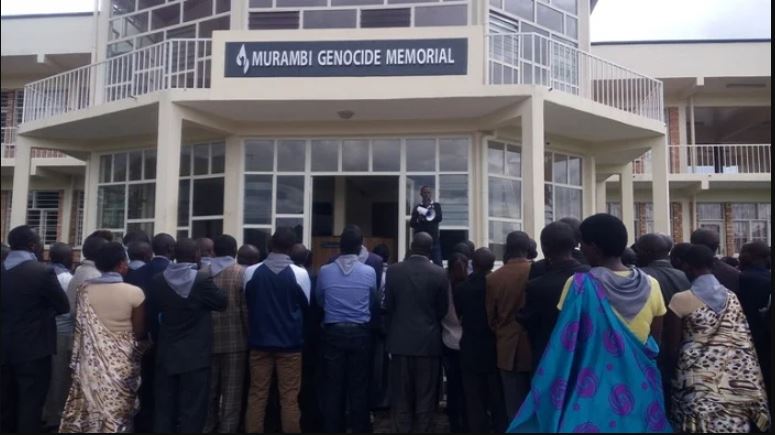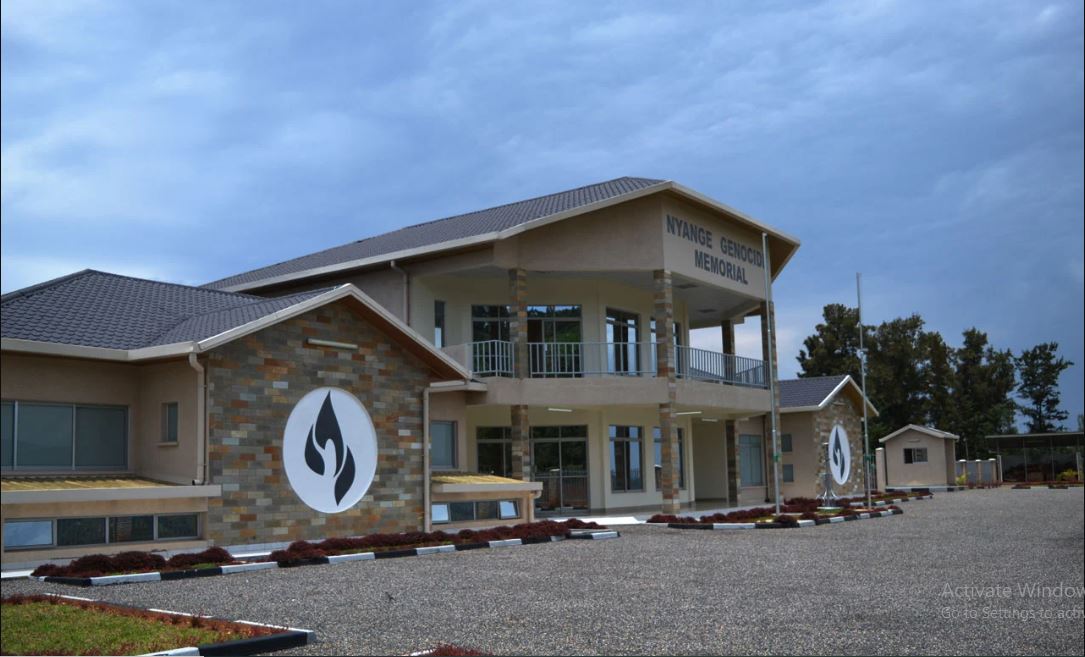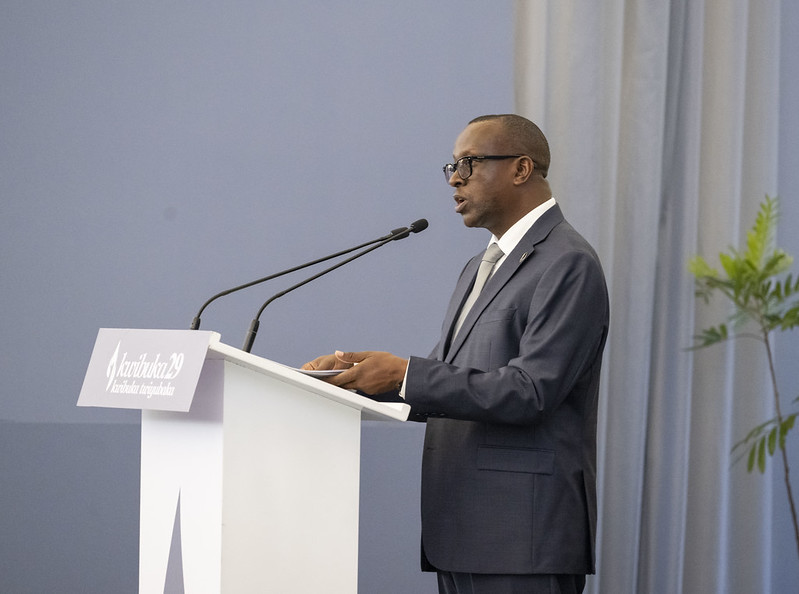
Murambi Genocide memorial. April 21, 1994 was a date where more than 50,000 Tutsi perished from here
Rwanda’s Minister of National Unity and Civic Engagement Dr. Jean Damascene Bizimana has once again elaborated how the plan of the Genocide against Tutsi started and matured to culminate to the tragedy in 1994 where more than one million innocent Tutsi were killed.
During the launch of the national commemoration week-Kwibuka29, April 7, Minister Bizimana, a seasoned research on Genocide matters said that the Genocide against the Tutsi is linked to colonialists, who never respected the treaty they had with the United Nations in 1922, which was later amended in 1946, under article 76.
Part of the treaty in this article provides that Belgium was supposed to give people they had colonized(including Rwanda), total liberty, in managing their own leadership affairs, with no discrimination based on ethnicity, sex, language, or religion.
However, on December 13, 1946, the Belgium government came out with a law abiding to this treaty, but later acted contrary, by introducing a system of administration in Rwanda, based on ethnicity, spearheaded by PARMEHUTU, an extremist political party which became the basis of the Genocide ideology from 1959.
“The effects of the Genocide ideology propagated in Rwanda still prevail at the moment,” Bizimana said.
Bizimana cut the story short and proceeded in the earlier 1990s to show how a corrupt regime executed the Genocide.
He said that from 1991, an operation named ‘Auto-Defense Civil’ or civil defense was created with an aim of training and arming the youth, and preparing them for massive killings. ‘
The operation was very instrumental in the execution of the Genocide, and several key dates were noted in this regard.
On July 09, 1991, the then Minister of Internal Security, Colonel Augustin Ndindiriyimana chaired a meeting at the Ministry of Defence, bringing together military officials, gendarmerie and presidential guards. They discussed the implementation of President Juvenal Habyarimana’s proposal to train the Interahamwe militia, “to create fear from anyone attempting to attack Rwanda.”
September 29 of the same year, the military commander in Umutara, Colonel Castar Nsabimana wrote to the Minister of Defence, informing him that in the four communes of Byumba, Muvumba, Muhura, Karama and Bwisige, they had selected 1,760 youth, at least one per village.
On February 07, 1992, an investigative report from Byumba, indicated that the selection was done clandestinely and the selected men were sent for training at Gabiro military training centre, from January 29, 1992, and that the number would be increased.
Meanwhile, earlier on January 20, 1992, the Minister of local government Faustin Munyazesa, ordered the Prefects of Gisenyi and Ruhengeri to work closely with the military commanders, so that they would be directed on procedures for training and distribution of firearms to the selected youth. The Ministry of Defence also introduced a special commission, composed of five high ranking military officials, to monitor the implementation of this plan at national level.
Military officers were also deployed in all prefectures to oversee the process of ‘Auto-Defense-Civil; military trainings held in army barracks, gendarmerie, tea factories, public institutions, and commercial enterprise, especially those owned by the tycoon Felicien Kabuga, a genocide suspect now in trial at the Hague.
Butare town was given special attention, because they wanted to weaken the opposition that was staged by the Social Democratic Party-PSD which was dominant in the area. They established two political wings; one for the youth, named ‘Front Commun Contre les Inklontanyi’, composed of university students, especially those belonging to the ‘Akazu’, from Gisenyi, Ruhengeri, and Byumba.
They went through military training conducted at the Military School ESO- Butare, then headed by Captain Ildephonse Nizeyimana. The top administration for this youth wing was based at the National University of Rwanda, headed by the Vice Rector Dr. Jean Berchimas Nshimyumuremyi.
Another political wing was known as ‘Groupe des intellectuelles Rwandais a Butare’, headed by Dr. Rwamucyo, and the two wings were used to reinforce killings in former Butare prefecture.
On July 02, 1993, Prime Minister, Dr. Dismas Nsengiyaremye, a member of MDR political party, wrote to the Minister of Defence Dr. James Gasana, who was a member of the ruling party-MRND, requesting him to stop the distribution of firearms and formation of lists, targeting those suspected to be accomplices of the ‘Inkontanyi’. After one month, on March 25, 1993, Dr. Nsengiyaremye reminded the Minister of Defence in an official letter, but this was all in vain, because training the Interahamwe militia and arming them continued.
During Bagosora’s case in Arusha, it was revealed that in January and February 1993, he distributed 500 firearms among the Interahamwe in commune Mutura, through Rubavu and Rwerere in Gisenyi.
In 1992 and 1993, Habyarimana appointed prefects, mostly from his political party, who were pro-genocide and they were deployed in their home prefectures, so that the dissemination of genocide propaganda would become easy.
Emmanuel Bagambiki was deployed to Cyangugu while Fronçois Karera was appointed in Kigali-rurale.
Dr. Clement Kayishema was sent to Kibuye, Laurant Bicyibaruta to Gikongoro, Basile Nsabumugisha to Ruhengeri, among others.
On February 17, 1994, Habyarimana convened a meeting for the leaders of gendarmerie and gave them instructions in the following words; If the RPF starts war, we have a plan to deal with their accomplices-ibyitso’.
It is against this background that in the same month the lists of the Tutsi in Kigali were finalized, so that they would be used in perpetrating genocide.
On March 29, 1994, General Nsabimana, who was the army chief of Staff chaired a meeting of top military officials and gendarmerie, from Kigali city and political parties affiliated to Hutu-Power, who commended the progress of the ‘Auto-Defense Civil’. The following morning, the Prefect of Kigali city Colonel Renzaho Tharcisse sent a list of the leaders of the Auto-Defense Civil in Kigali, to the army Chief of Staff.
Early April 1994, the government sent Ministers to their home prefectures, to work together with the Prefects and Burgomasters in speeding up the genocide. In Gitarama, they sent Calixte Nzabonimana, in Gisenyi was Augustin Ngirabatware and Butare was Pauline Nyiramasuhuko. Four Ministers originating from Kibuye were also sent; Eduard Karenmera, Emmanuel Ndindabahizi, Agnes Ntamabyariro and Eliezel Niyitegeka. All these Ministers were convicted of genocide crimes at the Arusha International Criminal Tribunal-ICTR.
When it comes to the execution of the Genocide, Bizimana brought clear facts and figures how it all started.
He said on April 07, at the commencement of the genocide, the Tutsi were killed in 24 identified locations, in 13 communes, in all prefectures.
Furthermore, in the week of April 07-14, 1994, they were killed in 84 identified locations, including over 30 churches including Nyange Catholic church, where Father Seromba ordered the demolition of a church on top of the Tutsi who had sought refuge in the same church.

Nyange Genocide Memorial
Of all dates however, April 21, 1994 remains the most incendiary. It is an unforgettable date in the history of Genocide against the Tutsi; first and foremost, it was a day when so many people were killed, countrywide. Over 2,500 people were killed in 34 identified locations, especially in the southern part of Rwanda.
In Murambi, over 50,000 victims were killed and in Cyanika, five kilometres from Murambi 35,000 victims were killed, in Kaduha, 30 kilometres of Murambi 47,311 victims were also killed, on the same day.
Further South in Ntongwe, Nyamukumba and Kayenzi, former Gitarama, over 50,00 were also killed.
In Butare, Karama Parish over 70,000 were also killed and others in different parts of Butare town. Others were killed at the National University of Rwanda, University Teaching Hospital, at ESO, the march factory, Kabutare, Groupe scolaire officiel, Caraeas, Ngoma, Cyarwa, Rugango Parish, commune Huye, Musha, Gishubi and Kibirizi in Gisagara and other places. All this happened on the same date of April 21, 1994.
These statistics indicate that ¾ of the Tutsi countrywide were killed during the month of April 1994. Another bad incident that marked this date of April 21 was when the United Nations voted resolution 912, to reduce the number of its peace keeping mission in Rwanda tenfold from 2,500 to only 250.
“This resolution appeased the former government, believing it was at liberty to continue with the genocide, with no obstacle,” Bizimana said.
Minister Bizimana said President Paul Kagame not only stopped the Genocide, but also continued to mind their well-being.
“Rwandans appreciate your role in stopping the genocide, restoring comfort and hope for life. Survivors were given another chance to live and co-exist with people who killed their beloved ones and enabling refugees to return back to their country,” he said.

Minister Jean Damascne Bizimana speaking at the launch of Kwibuka29
He further said, that the president acted with humanism in the wake of this tragedy.
“You reduced sentence for the Genocide perpetrators, giving them absolute rights despite having committed horrible atrocities. You pardoned leaders of armed groups and self-proclaimed politicians promoting hatred and those fighting the current government. This forgiveness for high profile criminals indicates your zeal to promote unity among Rwandans. This is the reason why we keep remembering, while contented about the progress Rwanda has made,” he said.
Minister Bizimana said, that the 29 years after the liberation of Rwanda have been a relief of the country, since they have been all peaceful.
“Since Rwanda got independence, this is the first time the country has spent 29 years without witnessing massive killings. Those still taken-up by the genocide ideology need to understand and do away with it, to join other Rwandans in strengthening the unity, striving for a better future and making rightful decisions,” he said.

